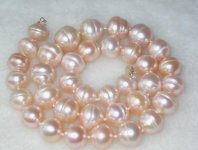olmander
Well-known member
- Joined
- Nov 28, 2007
- Messages
- 308
Can anybody explain to me why some Tahitian pearls grow with circles and some not? Why drops are mostly without circles while the circled Tahitians are more symmetrical?
In other words, what happens with the mollusk when it creates circles?
Sorry if I missed something and such a thread existed before, could not find anything on this topic.
I am looking at my new 36 inch long baroque Tahitian collier, which a vendor has put together for me with love and care, and enjoying all the blue, green, peacock and purple colours coming together with the circles. That's exactly why I like circles more than drops. But I failed to answer my husband's question WHY they became circled. Help!!!
Sorry for the photo - this time I could not catch all the colours hidden in the pearls...there is much more of them...
and they are still waking up after a long flight in a box...

Olga
In other words, what happens with the mollusk when it creates circles?
Sorry if I missed something and such a thread existed before, could not find anything on this topic.
I am looking at my new 36 inch long baroque Tahitian collier, which a vendor has put together for me with love and care, and enjoying all the blue, green, peacock and purple colours coming together with the circles. That's exactly why I like circles more than drops. But I failed to answer my husband's question WHY they became circled. Help!!!
Sorry for the photo - this time I could not catch all the colours hidden in the pearls...there is much more of them...
and they are still waking up after a long flight in a box...

Olga
Last edited by a moderator:



